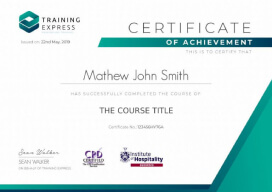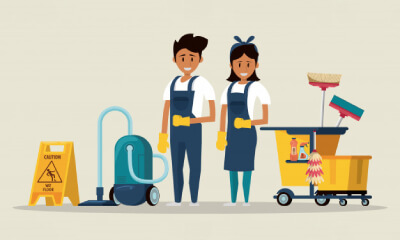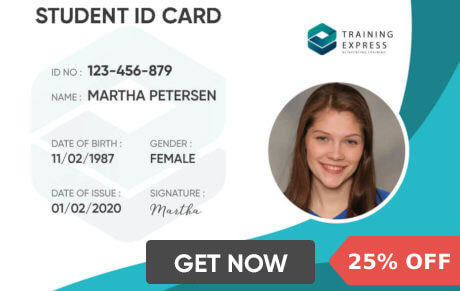GET THIS COURSE AND 1500+ OTHERS FOR ONLY £49 PER YEAR. FIND OUT MORE
***7 Courses Bundle | Free PDF Certificates | Unlimited Free Retake Exam***
If you’re looking to kickstart a career in cleaning or wish to establish your own cleaning business, but need to gain in-depth knowledge and skills about cleaning business and safety compliance, then this Cleaning Diploma course is perfect for you. It focuses on cleaning business and general workplace safety for cleaning professionals, covering everything you need to train your staff effectively. With step-by-step guidance led by an expert instructor, it includes all areas from workplace first aid to the different types of PPE.
You’ll learn how to establish a cleaning business, best practices for working at height for window cleaners, regulations for working in confined spaces, how to work safely with hazardous cleaning chemicals, and other essential topics. You’ll also explore common cleaning-related accidents and illnesses, with proper training and guidance on how to use different types of PPE.
By the end of this course, you’ll have an excellent understanding of the cleaning business and cleaning safety regulations in the UK, the skills to ensure your full compliance, and the knowledge of what to do in the event of an emergency in the workplace.
- Accredited by CPD
- Institute of Hospitality endorsed
- Instant e-certificate and hard copy dispatch by next working day
- Fully online, interactive course with audio voiceover
- Developed by qualified food safety professionals
- Self paced learning and laptop, tablet, smartphone friendly
- 24/7 Learning Assistance
- Discounts on bulk purchases
Sneak Peek
Who should take the course
This comprehensive course is ideal for individuals associated with the food sector, such as:
- Domestic Cleaners
- Window Cleaners
- Cleaning Business Owners
- Mobile Cleaners
- Cleaning Operatives
Certification
Once you’ve successfully completed your course, you will immediately be sent a digital certificate. Also, you can have your printed certificate delivered by post (shipping cost £3.99). All of our courses are fully accredited, providing you with up-to-date skills and knowledge and helping you to become more competent and effective in your chosen field. Our certifications have no expiry dates, although we do recommend that you renew them every 12 months.

Learning Outcomes
By the end of this training course, learners will be able to:
- Gain the fundamental skills required to clean a house, office or hotel thoroughly
- Get started in setting up your own cleaning service business and learn how to train your staff
- Learn how to work safely and compliantly with hazardous chemicals and substances
- Familiarise with commercial cleaning equipment and cleaning procedures
- Understand the safety regulations for working at height and in confined spaces
- Have solid knowledge of the most common causes of accidents, injuries and illness in the workplace
- Know how to provide quality first aid in the workplace and handle a work-related emergency
- Gain the practical skills to conduct safety risk assessments and train staff on PPE
- Get expert tips on how to market your cleaning services, find staff and advertise your business both online and offline
Assessment
At the end of the course, there will be an online assessment, which you will need to pass to complete the course. Answers are marked instantly and automatically, allowing you to know straight away whether you have passed. If you haven’t, there’s no limit on the number of times you can take the final exam. All this is included in the one-time fee you paid for the course itself.
Courses Contents
Level 5 Certificate in Cleaning
In module one, we will explore the role and responsibilities of a cleaner, covering topics such as typical working hours, cleaning contracts, expected pay, and holidays.
In module two, we will take a look at the different career opportunities in cleaning, discussing cleaning guidelines for new-build homes, pubs, leisure premises, and offices. It also includes window cleaning training and tips for cleaning carpets and upholstery.
In module three, we will familiarise with a range of commercial cleaning equipment and products, with tips on how to store equipment, remove stains from clothing and iron clothes.
In module four, we will explore cleaning standards and techniques for domestic cleaning, including dusting procedures, surface cleaning, mirror cleaning, and maintaining hardwood floors.
In module five, we will learn about domestic and hospitality kitchen cleaning procedures and best practice. It provides practical training on how to clean microwaves, ovens, refrigerators, sinks and other appliances.
In module six, we will learn all about bathroom cleaning and toilet cleaning, with an overview of equipment required. It covers procedures for unclogging drains, fixing showerheads, eliminating mould, washing shower curtains, and other tasks.
In module seven, we will learn the fundamental principles of office cleaning, from how to clean up and organise rubbish, to procedures for cleaning staff toilets, desks, lifts and stairways.
In module eight, we will learn techniques for cleaning external surfaces and areas, with guidance on how to carry out a risk assessment to identify potential safety hazards. It also provides guidance on how to use a commercial pressure washer.
In module nine, we will explore the principles of waste management, taking a look at colour coding systems, PPE, waste transfer control systems, and pharmaceutical disposal.
In module ten, we will learn how to use chemical cleaning equipment correctly and safely, with guidance on how to store chemical products, clean chemical storing and what to do in the case of a chemical emergency.
In module eleven, we will learn what it takes to run a cleaning service and establish a cleaning business from scratch. It covers practical guidance on how to create a business plan, market research, and set a budget.
In module twelve, we will gain a comprehensive understanding of the different aspects of running a cleaning business, from dealing with staff issues to now shows, conduct and ethics.
In module thirteen, we will develop our knowledge of customer satisfaction in the cleaning industry, with tips on how to recognise problems before they occur, as well as deal with client complaints.
In module fourteen, we will explore a range of staff management strategies, with guidance on key topics such as motivating and rewarding staff, how to conduct interviews, training staff and dealing with staff turnover.
In module fifteen, we will learn how to market a cleaning service, with guidance on how to decide locations and offices to target, advertise your services online, network and make the most of opportunities.
In module sixteen, we will explore strategies for business growth and retaining clients, including payroll management training.
In the final module, we will explore the options for insurance purchasing, taking a look at insurance for both cleaners and cleaning businesses, including insurance costs and tax regulations.
Personal Protective Equipment
Working at Height Training
Module one clarifies the definition of “Working at Height”, and provides statistics for the most commonly experienced incidents in the UK. We also look at the UK regulations (WAHR 2005) that govern this work and the legal responsibilities that employees and employers hold with this type of work.
In Module two, we explore the full process of applying risk assessment to planned work, where height-related tasks are required to be performed. It details the many types of hazards you can expect to encounter and how to prevent or minimise the opportunity for any harm to befall anyone.
In Module Three, the course examines the many types of equipment that a worker can expect to use during work at height. This leads to guidelines of how best to use devices such as MAWPs and Scaffolding, and the crucial inspection pointers for devices such as step-ladders and podium steps.
Working in Confined Spaces
Module one clarifies the definition of “Confined Spaces,” and why training for working inside one is essential. We also look at the UK and Irish laws that are in place for employees, which solidify the legal responsibilities of employers and property owners. The responsibilities of managers and other leadership positions are also examined.
In Module two, we fully explore the procedure of applying risk assessment to confined spaces, and how it should be conducted to produce the maximum effectiveness. The course also details the many types of hazards that can be encountered in this environment, and how to prevent any accidents or harm resulting from them. We consider the best ways to utilize the information from assessments and how to keep it relevant.
In Module Three, the course examines the many ways in which control measures can be put in place to prevent accidents in confined spaces. This leads to the benefits of installing a Safe Work System and the equipment that can be used to make the environment safer. We also look at the way communications, ventilation, and accessibility can be improved in a work environment.
In Module four, we detail the procedures and equipment that are essential or helpful during an accident or emergency. This covers the way in which the workforce should interact with emergency services and the importance of first aid. The module also looks at fire safety and useful training in greater detail.
Health and Safety Level 2
In module one, we will broaden our understanding of the dangers of poor health & safety in the workplace, taking a look at some statistics.
In module two, we will take a look at your legal responsibilities and the measures and procedures that can be taken to ensure optimum safety at work
In module three, we will learn how to conduct a risk assessment and explore some of the common risks to health & safety at work.
In module four, we will broaden our understanding of the types of health & safety-related issues in the workplace, covering topics such as work-related stress and violence at work.
In module five, we will gain an understanding of the types of reportable injury and how they are reported, as well as RIDDOR regulations.
In module six, we will learn about electrical maintenance, fire safety procedures in the workplace, and gas safety measures.
In module seven, we will look at health & safety for different work settings, covering topics such as manual handling and working at height.
In module eight, we will explore work equipment in detail, PPE selection and use, machinery hazards, and more.
In module nine, we will deepen our understanding of some other health & safety hazards at work, such as slips and trips and noise control.
First Aid at Work
Module One introduces the basic principles of First Aid in the workplace and the important responsibilities that a First-Aider must own. It also looks at the requirements of a good First Aid kit and the importance of preventing cross-infection. It also provides a pointer towards initial actions to take when an emergency is encountered.
In Module Two, we explain the legal duties of an employer (and employee) has in regards to providing First Aid equipment and facilities. It also covers the UK legislation that is currently in place, to ensure that the appropriate workers are trained in First Aid skills, along with further health and safety directives. The importance of accident reporting is examined as well.
In Module Three, we look at the way in which First Aid personnel should take charge during incidents and guide events. This naturally leads to the recommended actions to take during an emergency, where they will be influential in conducting safety during accidents involving fire, electricity, and water. This module also emphasises the need for self-safety as a First-Aider.
In Module Four, we look at the importance of a Primary Survey during an incident. It emphasises the importance of recording and understanding all the information that can be taken from the casualty and the incident. The module also instructs the way a Recovery Position can be applied to a patient.
Module Five explains the purpose of a Secondary Survey and why it may not always be necessary. It covers the benefits of a more protracted examination and detailed investigation into an incident. We explain the procedural steps of the survey and just how much it can influence the treatment of the casualty.
Module Six comprehensively describes the most commonly used First Aid techniques. We cover the “Chain of Survival”, and the key recommendations in an emergency. The components of a First Aid kit are also explored, with descriptions of how to apply dressings, bandages, and slings. The life-extending procedures involving CPR and AEDs are highlighted as well.
Module Seven describes the majority of minor injuries that a First-Aider can expect to encounter. It looks at the wide variety of common ailments and wounds that can occur easily, and how best to deal with them. The module also highlights the injuries that can escalate in severity and what to do to ensure the safety of the casualty.
Module Eight starts to cover the Secondary Illnesses that a First-Aider can come across. This module specifically explains the actions required when an adult, child, or baby becomes unconscious. It also goes into detail on how to check for breathing problems and apply resuscitation techniques.
Module Nine continues the theme of treating Secondary illness in a casualty. This module covers the conditions that can cause severe breathing difficulties in an individual, how they should be appropriately treated, and when emergency services should become involved.
Module Ten continues to look at Secondary Injuries that arise from long-time medical conditions or injuries. This covers a range of issues from complications caused by excessive bleeding, to the effects of Epilepsy, and the causes of Heart Attacks. The module also covers the different types of diabetes, and what causes the body to go into shock.
Module Eleven comprehensibly covers the different types of fractures and dislocations. It looks at the different ways bones can break or splinter, along with the appropriate treatment a First-Aider can perform. We also cover the risks behind head injuries and how bone displacement should be handled.
Module Twelve covers and summarises the different types of emergency services that are available in the UK. This final module will affirm the responsibilities of a First-Aider and instructs the learner on how and when to call the appropriate services.
Coronavirus (COVID-19) Awareness Course
In module one, we will learn how the coronavirus outbreak began and how it became a global health crisis. We will explore the possible causes of the outbreak, with a focus on zoonotic diseases.
In module two, we will explore the process of how COVID-19 spreads, gaining an insight into the different ways a person can be exposed to coronavirus. It covers the risk of contamination, as well as how coronavirus affects different age groups and ethnic groups.
In module three, we will look at the differences and similarities of the novel coronavirus, SARS and MERS, through an in-depth science-based comparison.
In module four, we will take a more in-depth look at the novel coronavirus of 2020 and why it is classified as a severe acute respiratory syndrome, including facts and statistics from the World Health Organisation.
In module five, we will learn about the sources of COVID-19, common symptoms to look out for and the infection rate of coronavirus in the UK.
In module six, we will explore the developments of a possible COVID-19 vaccine and how coronavirus is currently being treated. We will also learn about coronavirus contamination prevention measures.
In module seven, we will take a look at the latest information regarding COVID-19 in the UK, including government guidelines and legislation. It covers the latest developments in measures for stopping the spread of the virus and what we as individuals can to do to stay safe.
In module eight, we will familiarise with some of the latest information regarding the coronavirus outbreak, exploring worldwide statistics, facts and figures.
Course Curriculum
 TAKE THIS COURSE
TAKE THIS COURSE
£1,499.00£79.00 ex VAT- 1 year
- Advance, Diploma
- Course Certificate Gift this course
Subscribe to this course and 2,000+ top‑rated Training Express courses for your organization.
Try Training Express Business- For teams of 5 or more users
- 2,000+ fresh & in-demand courses
- Learning Engagement tools
- SSO and LMS Integrations
 Food Hygiene
Food Hygiene Health & Safety
Health & Safety Safeguarding
Safeguarding First Aid
First Aid Business Skills
Business Skills Personal Development
Personal Development









